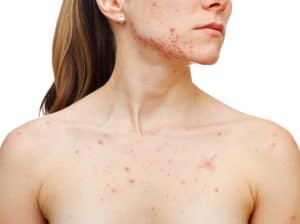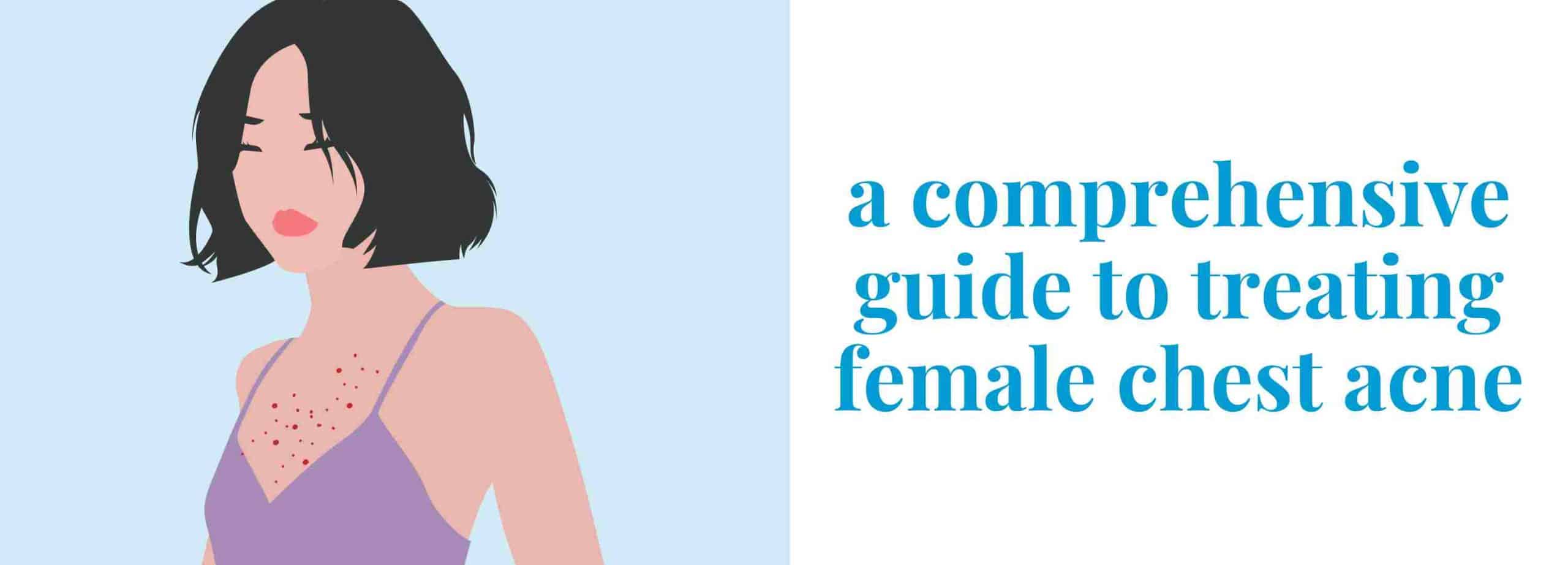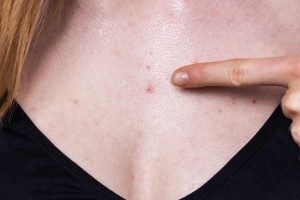Everyone deals with acne at some point in their lives. You can get acne anywhere you have oil glands, although it commonly appears on your face, back (back acne), shoulders, and chest. While acne mainly affects those in their teens, it can occur at any stage of your life.
Chest acne develops in much the same way as facial or chin acne. It has many causes, including hormonal changes, overproduction of your skin’s natural oils (sebum), skin cells sticking together, and other factors.
Let’s dive into the causes of chest acne breakouts and discover acne treatments that will help you take charge of your skin.

What Is Chest Acne?
Chest acne often happens when oil and dead skin cells clog your pores. Bacteria can grow when your skin pores become blocked, causing painful and inflamed pimples to develop. But what does it mean when your skin is overproducing oil and triggering breakouts? And is that the only reason for chest acne?
Sometimes, breakouts on your skin can be a reflection of what’s happening inside your body. When you’re experiencing acne on your chest, it can mean you’re going through hormonal changes. Fluctuations in hormones cause your sebaceous glands (your skin’s oil glands) to produce too much oil. But did you know that your skincare products, clothing, sweat, and even your choice of laundry detergent can cause chest breakouts?
How To Get Rid of Chest Acne Fast?
Sign up for Pandia Health and our expert doctors will find the best treatment for you.
Want to treat and get rid of chest acne? Pandia Health now offers online acne treatment. With telehealth services, you can get your prescription acne treatment (and birth control!) delivered.
What Causes Acne on the Chest?
There are many reasons you might be experiencing acne on your chest. Below are some of the most common culprits for this skin issue.
Chest acne causes are highly varied. For example, you might get this acne from hormonal fluctuations, skin hygiene (washing too often or not enough), sweating with tight fitting clothing during exercise, skincare products, medications, and even laundry detergent. These biological and environmental factors can clog your pores or irritate your skin, causing your skin to produce excess oil or leading to pore irritation and inflammation. Clogged pores make it easier for acne to thrive.
Hormonal fluctuations: Hormonal changes often happen during your teenage years and puberty, causing teen acne. In women and menstruating people, the causes of adult acne come from hormonal changes around their periods, pregnancy, menopause, or stopping hormonal birth control.
Skincare products: Some skincare and haircare products can cause chest acne. Moisturizers containing oils can block your pores, causing chest acne breakouts. Look for products labeled “non-comedogenic” to incorporate into your acne skincare routine. These products are often “oil-free” and won’t clog pores.
Sweat: Sweating during exercise and wearing tight or restrictive clothing that doesn’t breathe can contribute to acne breakouts on your chest. Therefore, wear loose-fitting clothing that won’t cause friction and obstruction of your pores while you exercise to avoid this skin issue. It’s also important to shower soon after exercise to clean your skin of sweat and dead cells, preventing them from clogging your pores.
Vitamins and medications: Some medications or supplements can cause acne on your chest. In particular, very high doses of vitamins B12, B2, and B6 (such as those used by body-builders) can cause acne breakouts when taken in high quantities. Certain prescription medications can also trigger acne breakouts such as prednisone, testosterone, progesterone only pills, hormonal IUD, birth control implant, lithium, INH, phenobarbital and more.
Laundry detergents: Washing your clothes is crucial for removing dirt and sweat from your clothing. However, laundry products often contain strong fragrances and harsh ingredients that can harm and irritate your skin. Look for products labeled “fragrance-free” or “hypoallergenic” to avoid further skin irritation. Skin irritation can cause acne.
How Can I Treat Chest Acne?
Treating acne on your chest can be as easy as showering regularly (no more than twice a day), exfoliating your chest, using a fragrance-free laundry detergent, and changing your skincare products. But, often, you might need to see a doctor about prescription treatments that get rid of chest acne.
Exfoliate Once a Week
Showering is essential in the fight against chest acne. Regular showering helps remove bacteria, dead skin cells, dirt, and excess oil from your skin before they can block your pores.
But showering isn’t usually enough. You should also exfoliate your chest once a week (don’t over-exfoliate!) to help remove dead skin cells.
Shower products that contain salicylic acid or benzoyl peroxide can help clear out excess oil, dead skin cells, and dirt from your skin. In addition, salicylic acid can help reduce the swelling and redness associated with body acne breakouts. Benzoyl peroxide has the added benefit of killing acne-causing bacteria. Also you can use physical exfoliants like loofah or exfoliating bath mitts.
Switch to a New Laundry Detergent
This option may be one of the easiest ways to get rid of acne on your chest. Although often this is not enough. This helps but does not usually solve the problem. The term “fragrance” in laundry soaps can include a whole load (pun intended) of harsh ingredients that leave residues on fabrics. When those residue-covered fabrics rub against your skin, they can cause irritation, inflammation, and oily skin from excess oil production. All of these outcomes can lead to acne.
To prevent chest acne, consider switching from your scented laundry detergent or fabric softener to a “fragrance-free,” “dye-free,” or “hypoallergenic” detergent. These products are less likely to irritate your skin or cause a chest acne breakout.
Use Gentle Cleansers
You may develop acne from the cleansers and skincare products you use. Therefore, a gentle cleanser can do wonders in treating chest acne. An unscented, mild cleanser helps remove the excess oil and dead skin cells that cause acne and may help your skin regain its pH balance.
This approach applies to your body lotion too! If you have acne-prone skin, look for lotions labeled “fragrance-free” or “non-comedogenic.” You could also search for cleansers formulated specifically for treating acne. These products will help treat and prevent acne on your chest while providing much-needed hydration for your skin.
Try a Prescription Medication
The above methods and over-the-counter products like salicylic acid and benzoyl peroxide can only go so far in treating and preventing chest acne.
If you’re struggling with stubborn chest acne, get some help! There’s no shame in reaching out to your doctor or the experts doctors at Pandia Health for ways to calm your skin issues. With Pandia Health, it’s never been easier to get prescription-grade topical (tretinoin) or oral acne treatment (antibiotics)with free delivery to your mailbox. Find your online acne treatment right here.
Takeaway
Chest acne is a common skin condition that causes pimples on your chest and shoulders. Chest acne causes vary, stemming from several hormonal and lifestyle factors. Now that we’ve covered how to decrease the risk of acne on your chest and how to treat chest acne, you should have the right information to forge ahead in your fight against pimples.
Pandia Health is dedicated to providing accurate and reliable health knowledge. Check us out on Instagram, Twitter, YouTube, and our other social channels for more information about acne treatments, women’s health, and lifestyle habits.
Disclaimer: This article is for general informational purposes and is NOT a substitute for professional medical advice. Always seek the advice of your healthcare provider before starting or changing acne treatment.



